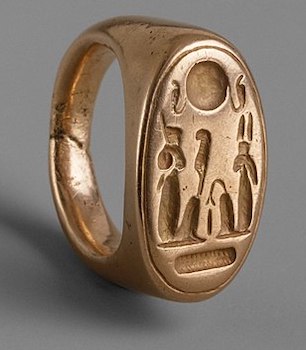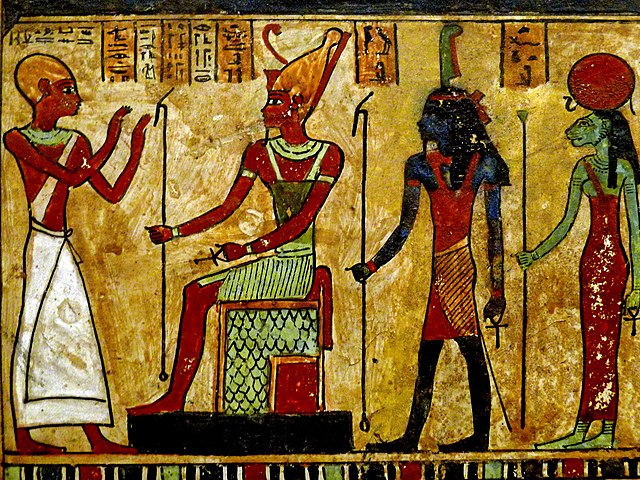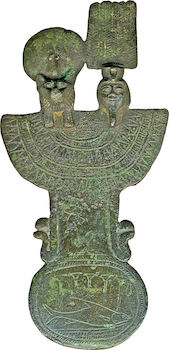

Tefnut (Tefenet, Tefnet) was an ancient Egyptian goddess of moisture, but was strongly associated with both the moon and the sun. She was known as both the left (moon) and the right (sun) “Eyes of Ra” and represented moisture (as a lunar goddess) and dryness (or the absence of moisture, as a solar goddess). Her name means “She of moisture” and its root can be found in the Egyptian words for “moist” and “spit”.


Tefnut was generally depicted as a lioness or a woman with a lion’s head. Less often, she was depicted as a woman. She always wears a solar disk and Uraeus, and carries a sceptre (representing power) and the ankh (representing the breath of life). She also occasionally took the form of a cobra.
She was originally considered to be the lunar “Eye of Ra” linking her to the night sky as well as to dew, rain, and mist. However, she also took on the aspect of the sun as the solar “Eye of Ra”, the protector of the sun god (also known as the “Lady of the Flame” and the “Uraeus on the Head of all the Gods”). She shared this role with a number of other goddesses including Sekhmet, Hathor, Mut, Bast, Isis, Wadjet, and Nekhbet.

Her family background is fairly complex. She was originally associated with a god called Tefen. The Pyramid Texts inscribed in the tomb of Unas suggest that Tefnut and Tefen were closely involved in the weighing of the heart of the deceased by Ma’at. The text states; “Tefen and Tefnut have weighed Unas and Ma’at has listened, and Shu has born witness.” However, Tefen seems to have disappeared into obscurity (one of the scorpions who accompanied Isis was called Tefen, but this may be a coincidence) and Tefnut’s role changed somewhat as time progressed, although she retained her connection with Ma’at. In Heliopolis (Iunu, On) and Thebes (Waset) she was generally described as the daughter of the creator god (Amun, Atum, or Ra), the sister-wife of Shu, and the mother of Geb and Nut. She was sometimes shown helping Shu to hold Nut (the sky) above Geb (the earth). While, in Memphis she was also known as the “Tongue of Ptah” who had apparently helped him create life. Part of the city of Denderah (Iunet) was known as “The House of Tefnut” and she was worshipped in her lion form at Leontopolis (Nay-ta-hut).

According to legend, Shu and Tefnut went out into the waters of Nun (chaos). Their father, Ra, thought that he had lost them and sent his eye to find them. When they returned Ra was so happy that he wept, and his tears formed the first human beings.

Another legend states that Tefnut fell out with her father, Ra, while he lived on earth as the Pharaoh of Egypt. She left Egypt for Nubia taking all of the water and moisture with her. The fertile land soon dried up and the people suffered. Meanwhile, Tefnut was rampaging through Nubia in her leonine form. Ra eventually sent Thoth and Shu to get her back. When she returned (bringing the inundation with her) she visited each town in Egypt and there was much celebration and rejoicing throughout the land.
This story may have originally referred to Anhur (also known as Onuris, who is associated with Shu ) and his wife Menhet (who also took leonine form). In another version of the tale it is Hathor or (Sekhmet) in her form of the “Eye of Re” who has left for Nubia and she has gone because she was tricked with blood coloured beer to prevent her from destroying mankind.
During the reign of Akenaten when many of the old gods were rejected, Tefnut and Shu remained in favour and Akhenaten and Nefertiti were often depicted as the twin lion gods. This suggests that Atenism was not in fact a monotheistic religion, but a henotheistic solar religion.
Bibliography
- Hornung, Erik (1999) The Ancient Egyptian Books of the Afterlife
- Pinch, Geraldine (2002) Handbook Egyptian Mythology
- Redford Donald B (2002) Ancient Gods Speak
- Watterson, Barbara (1996) Gods of Ancient Egypt
- Wilkinson, Richard H. (2003) The Complete Gods and Goddesses of Ancient Egypt
- Wilkinson, Richard H. (2000) The Complete Temples of Ancient Egypt
Copyright J Hill 2018